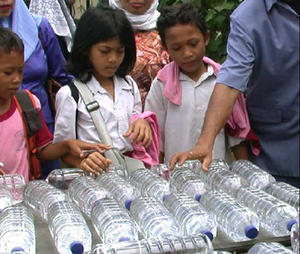WaterSolar UV disinfects drinking water
More than 800 million people around the world lack access to clean water; the water available for people to drink in many developing countries has not been treated to remove contaminants, including pathogenic microorganisms; half of the world’s hospital beds are occupied by people who are sickened by the water they drink; Purdue University researchers have invented a water-disinfection system that uses the sun’s ultraviolet radiation to inactivate waterborne pathogens

A simple, effective method of UV water disinfection // Source: edu.ph
A team of Purdue University researchers has invented a prototype water-disinfection system that could help the world’s 800 million people who lack safe drinking water.
The system uses the sun’s ultraviolet radiation to inactivate waterborne pathogens. Sunlight is captured by a parabolic reflector and focused onto a UV-transparent pipe though which water flows continuously.
“We’ve been working on UV disinfection for about 20 years,” said Ernest “Chip” R. Blatchley III, a professor of civil engineering. “All of our work up until a couple years ago dealt with UV systems based on an artificial UV source. What we are working on more recently is using ultraviolet radiation from the sun.”
A Purdue University release reports that what motivated the research is the need to develop practical, inexpensive water-treatment technologies for a large segment of the world’s population in developing nations.
“More than 800 million people lack access to what we consider to be ‘improved’ water,” Blatchley said. “The water available for people to drink in many developing countries hasn’t been treated to remove contaminants, including pathogenic microorganisms. As a result, thousands of children die daily from diarrhea and its consequences, including dehydration. Half of the world’s hospital beds are occupied by people who are sickened by the water they drink.”
Blatchley built the parabolic reflector in his garage. The team, including an undergraduate student supported by a National Science Foundation (NSF) program, finished the prototype in the lab, lining it with aluminum foil. The system was then tested on the roof of Purdue’s Civil Engineering Building.
“It turns out that the solar radiation we receive in Indiana at some times of year is intense enough to inactivate some waterborne microorganisms with this type of system,” he said. “We demonstrated that we can disinfect water using sunlight. The reactor was very inexpensive to build, less than $100 for the materials.”
The natural UV system inactivated E. coli bacteria. The system, however, must be able to kill dangerous pathogens such as Vibrio cholerae, which causes cholera, and Salmonella typhi, which causes typhoid, and Cryptosporidium parvum, which causes cryptosporidiosis, a parasitic disease that causes diarrhea.
“In the future we want to prove that our solar-UV system is going work against these other pathogens,” said Blatchley, who has worked on the project with doctoral student Eric Gentil Mbonimpa, who is from Rwanda, and Bryan Vadheim, an undergraduate from Montana State University. “We also want to automate it and build sensors for it
